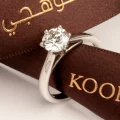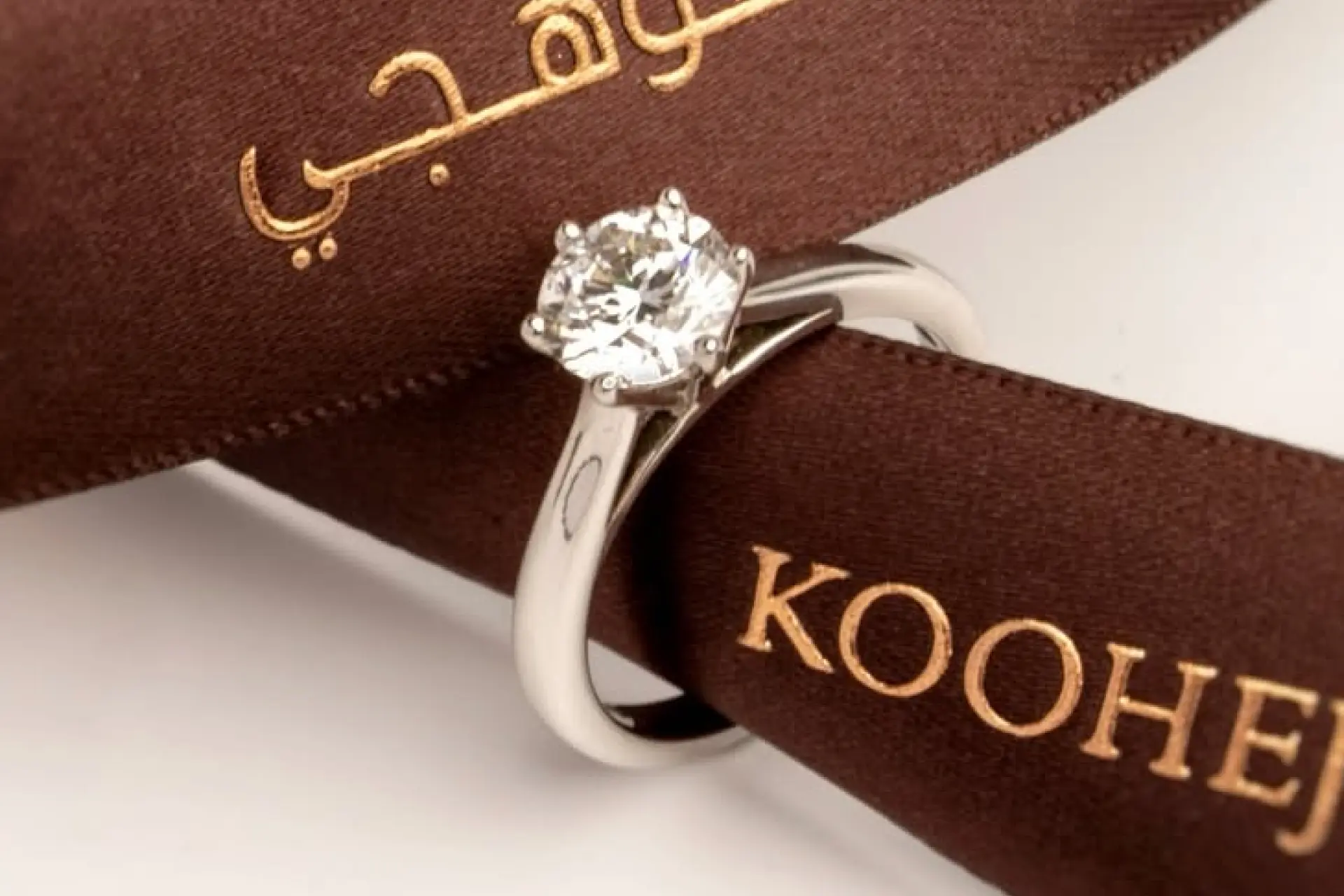What Diamond Cut Sparkles the Most? The brilliance of a diamond is one of the most important factors that determine its beauty and value. This brilliance depends largely on the quality of its cut, along with other factors such as clarity, color, and carat weight. If you’re looking for the most brilliant diamond cut, the first choice is a round brilliant cut, making sure to select an “excellent” or “very good” cut to ensure maximum brilliance. Learn more in A Comprehensive Guide to Diamond Cuts.
What Diamond Cut Sparkles the Most? A Complete Sparkle Guide for Shoppers
If you’re looking for the most brilliant and sparkling diamond, the Round Brilliant Cut is the undisputed choice. Why is the Round Brilliant Cut the Most Brilliant:
- Enhanced Light Reflection Design: The Round Brilliant Cut was developed in the early 20th century, specifically by mathematician and physicist Marcel Tolkowsky in 1919, with the goal of maximizing brilliance and sparkle.
- Number of Facets and Symmetry: This cut typically has 57 or 58 facets (facets) at precise angles and carefully designed to maximize light reflection and dispersion (fire). This strategic arrangement of facets allows light to enter the diamond, bounce, and refract multiple times within it before being reflected back from the top, creating a stunning display of brilliance and sparkle.
- Brilliance: The total amount of white light reflected from a diamond.
- Fire: The dispersion of white light into the different colors of the spectrum.
- Scintillation: The flashes of white light that appear when a diamond is moved.
- The circular cut excels at producing these three effects combined to the greatest degree.
What Makes a Diamond Sparkle? Understanding the Science of Brilliance
The dazzling brilliance of a diamond is the result of complex light behavior, especially how it interacts with the diamond’s proportions and polish. For full sparkle potential, see Professional Diamond Clarity to understand how internal features impact light performance.
The Role of Light Reflection, Refraction, and Scintillation
- Internal Reflection: When light enters a diamond, it repeatedly bounces off the diamond’s internal facets before exiting. The more precisely the facets are cut, the more light is reflected within the stone.
- Refraction: When light travels from one medium to another (in this case, from air to a diamond), it bends or refracts. Diamonds have a high refractive index, meaning they slow down and bend light significantly, contributing to their brilliance.
- Dispersion: A diamond’s ability to split white light into the colors of the spectrum (the colors of the rainbow). This is known as a diamond’s “fire.” When white light passes through a diamond, it disperses into its component colors (red, orange, yellow, green, blue, and violet), creating beautiful colorful flashes.
Why “Cut” Trumps Carat and Clarity for Sparkle
The flashes of light and dark that occur when a diamond or light source moves. It’s the contrast between light and dark areas that adds life and movement to a diamond’s sparkle. The greater the contrast and clarity of the patterns, the greater the brilliance.
How Gem Labs Measure Sparkle (Brilliance vs Fire vs Scintillation)
- Brilliance: The total amount of white light reflected from both inside and outside a diamond. It’s the overall brightness that makes a diamond appear vibrant. A well-cut diamond reflects most of the light back through the top, increasing its brilliance.
- Fire: The colored flashes you see within a diamond, resulting from the dispersion of white light into the colors of the spectrum. These colors appear when light rays scatter as they exit the facets.
Ranking the Sparkliest Diamond Cuts – From Round to Emerald
When classifying diamond shapes from most brilliant to least brilliant (from round to emerald), we can arrange them as follows:
Ound Brilliant Cut: The King of Sparkle
Round Brilliant Cut: The most brilliant and sparkling diamond. It is mathematically designed to maximize light reflection and dispersion (sparkle and fire). It typically contains 57 or 58 precisely arranged facets.
Other Cuts That Compete: Princess, Radiant, Cushion
- Princess Cut: This diamond comes in next in terms of brilliance. It features a square or rectangular shape and a brilliant cut facet arrangement that allows for strong light reflection. It has a large number of facets (approximately 76), giving it a strong sparkle.
- Radiant Cut: This cut combines the brilliance of a round diamond with the elegant lines of an emerald. It features many facets that enhance its brilliance and fire, making it a popular choice for those seeking a radiant and elegant look.
- Cushion Cut: It offers a soft brilliance with high light dispersion (fire). Although its brilliance is less than that of a round diamond, its large facets enhance light reflection. It is often referred to as a “cushion” cut because of its square or rectangular shape with rounded corners.
Sparkle-Limited Cuts: Emerald, Asscher, and Baguette
- Asscher Cut Diamond: Brilliance and Sparkle: Although less brilliant than the round brilliant cut, it has a strong brilliance and a “hall of mirrors” effect created by its stepped facets. It has 76 facets, giving it a special sparkle. Due to its large, flat facets, inclusions are more visible in this cut. Therefore, it is preferable to choose an Asscher diamond with good clarity (IF, VVS, or even VS) to ensure a flawless appearance.
- Baguette Cut Diamond: Brilliance and Sparkle: Due to its fewer facets, a baguette diamond does not reflect light as much as other cuts, which may have up to 50 facets or more. Therefore, it is not as brilliant and radiant, but it has a special elegance and soft brilliance. Due to its fewer facets, flaws are more easily detected. Therefore, clarity is an important factor when choosing a baguette diamond.
Diamond Cut Charts and Sparkle Comparisons [With Visuals]
A diamond’s cut pattern plays a crucial role in determining its brilliance, sparkle, and fire. The finer and more symmetrical the cut, the more perfectly the diamond reflects light, resulting in a dazzling brilliance, such as:
Ideal Cut Proportions for Maximum Sparkle
Round Brilliant Cut: The most common and preferred cut for its brilliance, flash, and fire. It features 58 precisely designed facets to maximize light reflection. It is considered the gold standard in brilliance.
Sparkle Comparison Table – Cut vs Fire vs Brilliance Ratings
- Princess Cut: A modern square or rectangular shape with sharp corners, offering an attractive sparkle.
- Cushion Cut: A square or rectangular shape with rounded corners, combining vintage and contemporary elegance with a soft sparkle.
- Oval Cut: An elegant oval shape that offers similar sparkle to a round cut, yet appears larger for the same carat weight.
- Marquise Cut: A rectangular shape with pointed ends, giving the illusion of an elongated finger.
How Lab Reports Reflect Sparkle Potential (GIA vs IGI vs AGS)
The round brilliant cut is considered the best in terms of brilliance, followed by princess and cushion cuts, which offer very good brilliance. Other shapes, such as emerald and asher, focus more on the clarity and color of the diamond due to the stepped nature of their facets, which create a different effect of light.
Choosing the Right Sparkling Diamond for Your Style & Budget
When choosing a diamond that suits your taste and budget, there are several key factors to consider to ensure you get the best value and the most beautiful sparkle. Apply the following factors:
Sparkle vs Size: When to Prioritize Cut Over Carat
When it comes to the beauty and brilliance of a diamond, cut takes precedence over carat. Here’s when and why you should choose cut over carat:
- When brilliance and sparkle are top priorities: If your primary goal is a diamond with dazzling brilliance and eye-catching sparkle, you should prioritize the quality of the cut. An excellent/ideal cut diamond will sparkle most strikingly, even if it’s slightly smaller.
- For the best value for money in visual beauty: A higher-carat, poorer-cut diamond may be less expensive, but it will appear dull and unattractive. Conversely, an excellent-cut diamond, even a lower-carat diamond, can appear larger and more beautiful due to the way it interacts with light. Investing in a good cut ensures you get the most brilliance and beauty for your money.
Setting Styles That Enhance Sparkle (Halo, Bezel, Pave)
Brilliance and Cut: The only factor that determines how a diamond interacts with light. Cut does not refer to the shape of the diamond (such as round or oval), but rather to how precisely the facets are cut and how they interact with light. A well-cut diamond will reflect most of the light back to your eye, creating exceptional brilliance, fire, and sparkle. A poorly cut diamond will allow light to escape from the sides or bottom, resulting in a dull and lifeless appearance, even if it weighs a lot.
Tips for In-Person vs Online Sparkle Evaluation
- Choose a reputable seller: Look for reputable online jewelers with positive reviews. Check if they have a physical address and clear contact information.
- Rely on the “4Cs” and certifications: Since you can’t inspect a diamond in person, a quality certificate from a recognized laboratory (such as the GIA) becomes crucial. Ensure the diamond you purchase comes with a detailed certificate.
- Use interactive viewing tools: Many websites offer high-resolution photos and videos of diamonds, and even virtual try-on features. Use these tools to evaluate the cut, color, and clarity in as much detail as possible.
- Read customer reviews: Reviews from other customers can provide valuable insights into the quality of the diamond and the seller’s customer service.
- Understand return and exchange policies: Make sure the seller has a clear and flexible return and exchange policy in case you are not satisfied with your purchase.
FAQs: What You Should Know Before You Buy
Is Sparkle the Same as Brilliance?
Not exactly. Brilliance is one part of sparkle. For clarity on terms, see Understanding the Diamond Color Grading.
Does Diamond Color Affect Sparkle?
Yes, the color of a diamond affects its brilliance, but less significantly than cut and clarity.
Can a Lower-Cost Diamond Still Sparkle Brilliantly?
Yes, lower-cost diamonds can sparkle, but the quality of the sparkle may vary greatly compared to higher-priced diamonds.






